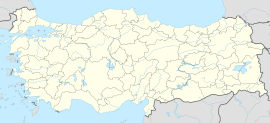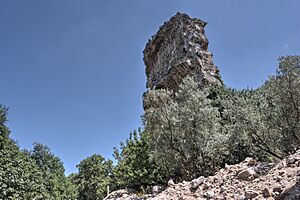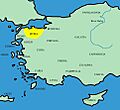Cyzicus facts for kids
|
Κύζικος (Greek)
آیدینجق (Ottoman Turkish) |
|

Bas relief of a charioteer, late 6th century BC
|
|
| Location | Erdek, Balıkesir Province, Turkey |
|---|---|
| Region | Mysia |
| Coordinates | 40°23′16″N 27°52′14″E / 40.387751°N 27.870445°E |
| Type | Settlement |
| History | |
| Builder | Pelasgian settlers |
| Abandoned | 11th century AD |
| Periods | Archaic Greek to High Medieval |
| Cultures | Greek, Ancient Roman, Byzantine |
| Events | Siege of Cyzicus |
Cyzicus (/ˈsɪzɪkəs/; Ancient Greek: Κύζικος Kúzikos; Ottoman Turkish: آیدینجق, Aydıncıḳ) was an amazing ancient Greek city. It was located in a region called Mysia in what is now Turkey. You can find its ruins in the Balıkesir Province today.
Cyzicus was built on a special piece of land. This land, now called the Kapıdağ Peninsula, was once an island. It later connected to the mainland. This happened either because people built a path or because of an earthquake. The old city site is now protected by Turkey's Ministry of Culture.
Contents
Discovering Ancient Cyzicus
Cyzicus was a very important city in ancient times. It was founded by people called Pelasgians. Later, many settlers came from another Greek city, Miletus.
A City of Trade and Battles
Cyzicus became very important because of its great location. It was on key sea routes. These routes connected Greece to the Black Sea. This made Cyzicus a busy trading hub.
During the Peloponnesian War, Cyzicus was caught between Athens and Sparta. In 410 BC, a big naval battle happened here. The Athenian fleet, led by Alcibiades, completely defeated the Spartan fleet. This was known as the Battle of Cyzicus.
The city was also famous for its gold coins. These coins, called staters, were used for trade everywhere. They were so valuable that they were like the US dollar of the ancient world!
Under New Rulers
After the Peloponnesian War, Cyzicus became part of the Persian Empire. But then, Alexander the Great captured it in 334 BC. Some say he was the one who connected the island to the mainland.
Later, Cyzicus became friends with Rome. In 74 BC, a powerful king named Mithridates VI of Pontus tried to attack the city. He had a huge army of 300,000 soldiers! But Cyzicus bravely defended itself. The Roman general Lucullus helped them. Because of their loyalty, the Romans gave Cyzicus more land and special rights.
Under the Roman Emperor Tiberius, Cyzicus officially joined the Roman Empire. It became a major city and the capital of the region called Mysia.
Cyzicus in the Middle Ages
Cyzicus faced tough times in the Middle Ages. It was briefly captured by Arab armies in AD 675. A series of strong earthquakes also hit the city. The last big one was in 1063. These earthquakes caused a lot of damage.
Because of the damage, many people moved away. By the 13th century, the city was mostly empty. The area later became part of the Ottoman Empire.
Amazing Ancient Buildings
Today, Cyzicus is mostly ruins. But you can still see some incredible structures.
- City Walls: You can trace the old city walls. They were built in the fourth century.
- Amphitheatre: Cyzicus had one of the largest amphitheatres in the world! It was like a giant stadium. It was nearly 500 feet (150 m) across. People started building it in the 1st century. Some even thought it was one of the seven wonders of the ancient world.
- Temple of Hadrian: There are also huge foundations of a temple dedicated to Emperor Hadrian. The columns of this temple were incredibly tall, about 21.35 meters (70 feet) high! This makes it one of the tallest Greco-Roman temples ever built.
Sadly, many stones from Cyzicus's grand buildings were later used to build other structures. For example, the Byzantine emperor Justinian used stones from here for his famous Hagia Sophia cathedral.
Famous People from Cyzicus
Many interesting people came from Cyzicus:
- Eudoxus of Cyzicus: A famous explorer and navigator from 130 BC.
- Proclus of Constantinople: An important religious leader in the 5th century.
- Germanus of Constantinople: Another significant religious figure from the early 8th century.
- Iaia: A talented female painter, sculptor, and ivory engraver.
Images for kids
-
Coin of Cyzicus, minted in the Achaemenid Persian Empire. This coin shows a Persian archer.









